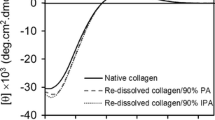Abstract
We were able to separate pepsin-solubilized collagen of the bovine vitreous body into three distinct fractions by differential salt precipitation with 0.5 M acetic acid containing 0.7 M, 1.2 M, and 2.0 M NaCl, respectively. The 0.7 M NaCl fraction showed (1) an electrophoretic mobility in polyacrylamide gel identical to that of type II collagen, (2) CNBr-derived peptides very similar to type II collagen CNBr-peptides, and (3) a reaggregation behaviour closely related to type II collagen as observed by electron microscopy. Therefore, the fibres of the bovine vitreous body appear to contain a mixture of a collagen very similar to type II collagen precipitable in the presence of 0.7 M NaCl, at least two different collagen types that can be precipitated at 1.2 M, and 2.0 M NaCl concentrations that have not been identified previously.
Similar content being viewed by others
References
Burke, JM (1980) An analysis of rabbit vitreous collagen. Connect Tissue Res 8: 49–52
Chapman JA (1976) Preparation of fibrous long spacing collagen. In: Hall DA (ed) Methods of connective tissue research. Joynson-Bruvvers Ltd, Oxford, pp 63–72
Furthmayr H, Timpl R (1971) Characterization of collagen peptides by sodium dodecylsulfate-polyacrylamide electrophoresis. Anal Biochem 41: 510–516
Gross J, Matoltsy G, Cohen C (1955) Vitrosin: A number of the collagen class. J Biophys Biochem Cytol 1: 215–220
Hasilik A, Neufeld EF (1980) Biosynthesis of lysosomal enzymes in fibroblasts. Synthesis as percursors of higher molecular weight. J Biol Chem 255: 4937–4945
Highberger JH, Gross J, Schmitt FO (1951) The interaction of mucoprotein with soluble collagen; an electron microscope study. Proc Natl Acad Sci USA 37: 286–291
Hofmann H, Schmut O (1977) Vergleich der Bromcyanbruchstücke von Glaskö rperkollagen und Typ II Kollagen. Graefe's Arch Clin Exp Ophthalmol 204: 281–285
Liang JN, Chakrabarti B (1981) Spectroscopic studies on pepsinsolubilized vitreous and cartilage collagens. Curr Eye Res 1: 175–181
Lilja S, Barrach HJ (1981) An electron microscopical study of the influence of different glycosaminoglycans on the fibrillogenesis of collagen type I and II in vitro. Virchows Arch (Pathol Anat) 390: 325–338
Linsenmayer TF, Little CD (1978) Embryonic neural retina collagen: In vitro synthesis of high molecular weight forms of type II plus a new genetic type. Proc Natl Acad Sci USA 75: 3235–3239
Linsenmayer TF, Gibney E, Little CD (1982) Type II collagen in the early embryonic chick cornea and vitreous: immunoradiochemical evidence. Exp Eye Res. 34: 371–379
Matoltsy AG (1952) A study on the structural protein of the vitreous body (vitrosin). J Gen Physiol 36: 29–37
Miller EJ (1972) Structural studies on cartilage collagen employing limited cleavage and solubilization with pepsin. Biochemistry 11: 4903–4909
Newsome DA, Linsenmayer TF, Trelstad RL (1976) Vitreous body collagen. Evidence for a dual origin from the neural retina and hyalocytes. J Cell Biol 71: 59–67
Olsen BR (1965) Electron microscope studies on collagen. IV. Structure of vitrosin fibrils and interaction properties of vitrosin molecules. J Ultrastruct Res 13: 172–191
Pirie A, Schmidt G, Waters JW (1948) Ox vitreous humour. 1. The residual protein. Br. J Ophthalmol 32: 321–339
Schmut O, Reich ME, Hofmann H (1979) Isolation of different hydroxyproline containing proteins from bovine vitreous body collagen. Graefe's Arch Clin Exp Ophthalmol 211: 329–332
Smith GN Jr, Linsenmayer TF, Newsome DA (1976) Synthesis of type II collagen in vitro by embryonic chick neural retina tissue. Proc Natl Acad Sci USA 73: 4420–4423
Swann DA, Constable IJ, Harper E (1972) Vitreous structure. III. Composition of bovine vitreous collagen. Invest Ophthalmol Vis Sci 11: 735–738
Swann DA, Caulfield JB, Broadhurst JB (1976) The altered fibrous form of vitreous collagen following solubilization with pepsin. Biochim Biophys Acta 427: 365–370
Swann DA, Sotman SS (1980) The chemical composition of bovine vitreous-humour collagen fibres. Biochem J 185: 545–554
Young RG, Williams HH (1954) Biochemistry of the eye. II. Gelatinous protein of vitreous body. Arch Ophthalmol 51: 593–595
Von der Mark K, von der Mark H, Timpl R, Trelstad RL (1977) Immunofluorescent localization of collagen types I, II, and III in the embryonic chick eye. Dev Biol 59: 75–85
Author information
Authors and Affiliations
Rights and permissions
About this article
Cite this article
Schmut, O., Mallinger, R. & Paschke, E. Studies on a distinct fraction of bovine vitreous body collagen. Graefe's Arch Clin Exp Ophthalmol 221, 286–289 (1984). https://doi.org/10.1007/BF02134125
Received:
Issue Date:
DOI: https://doi.org/10.1007/BF02134125




